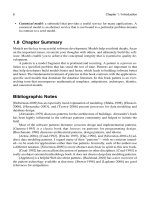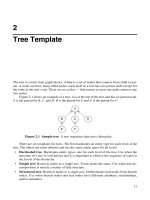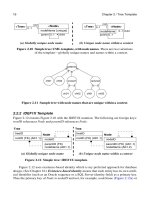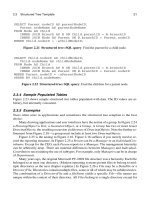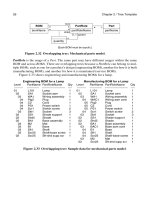PATTERNS OF DATA MODELING- P35 pdf
Bạn đang xem bản rút gọn của tài liệu. Xem và tải ngay bản đầy đủ của tài liệu tại đây (147.64 KB, 5 trang )
Bibliographic Notes 155
and UML qualifiers are important aspects of intrinsic identity. Names are prominent in mod-
els and can be helpful for finding specific data.
Bibliographic Notes
[Khoshafian-1986] is a classic reference on identity, but the ideas in the paper reach beyond
programming languages and also pertain to databases.
Chapter 5 of [Fowler-1997] has a good discussion of identity.
Chapter 4 of [Arlow-2004] discusses identity for persons and organizations. Chapter 7
discusses identity for products.
References
[Arlow-2004] Jim Arlow and Ila Neustadt. Enterprise Patterns and MDA: Building Better Software
with Archetype Patterns and UML. Boston, Massachusetts: Addison-Wesley, 2004.
[Feldman-1986] P. Feldman and D. Miller. Entity model clustering: Structuring a data model by ab-
straction. Computer Journal 29, 4 (1986), 348–360.
[Fowler-1997] Martin Fowler. Analysis Patterns: Reusable Object Models. Boston, Massachusetts:
Addison-Wesley, 1997.
[Khoshafian-1986] S.N. Khoshafian and G.P. Copeland. Object identity. OOPSLA ‘86 as ACM SIG-
PLAN 21, 11 (November 1986), 406–416.
157
Part V
Canonical Models
Chapter 12 Language Translation 159
Chapter 13 Softcoded Values 168
Chapter 14 Generic Diagrams 186
Chapter 15 State Diagrams 198
Part V presents several canonical models — models that often appear and cut across individ-
ual applications. These models are services with logic that stands apart from the various ap-
plications that use them. The canonical models contrast with the archetypes, in that
archetypes revolve around a basic concept found in models, while canonical models are
complete models that can be used as part of a larger application.
Chapter 12 presents several approaches to the translation of human languages. Software
that is written for international markets must be able to support multiple languages such as
English, Spanish, and Chinese. Data can often be stored in the language of entry, but there
is a need to translate metadata, such as labels in forms and reports.
Chapter 13 covers softcoded values. The usual approach is to hardcode attributes in
entity types and the resulting tables. As an alternative, values can be softcoded — metadata
specifies the intended model and generic tables store the values. Softcoded values are appro-
priate for applications with uncertain data structure; softcoding adds stability to the data rep-
resentation, minimizes changes to application logic, and reduces the likelihood of data
conversion. On the downside, softcoded values add complexity and incur a modest perfor-
mance penalty.
Chapter 14 discusses generic diagrams, diagrams that display as a picture and have un-
derlying semantic content. The generic diagram model provides a starting point for various
kinds of diagrams such as data structure diagrams, data flow diagrams, state diagrams, and
equipment flow diagrams.
Chapter 15 explains state diagrams for specifying states and stimuli that cause changes
of state. State diagrams are helpful for applications with a lifecycle or a sequence of steps to
enforce. Such information can be declared in database tables, rather than encoded via pro-
gramming. One group of tables specifies state diagrams that generic code interprets. Another
set of tables can store data from an application’s execution of state diagrams.
The canonical models have some complexity that illustrates the power of modeling.
They leverage some of the patterns shown in earlier chapters.
159
12
Language Translation
Much of today’s software is written for an international market. Worldwide sales enable ven-
dors to maximize profits. In addition multinational companies often must build systems that
cut across countries, cultures, and languages. Language translation can be a difficult issue.
Data often is stored in the language of entry, but there can be a need to translate metadata,
such as labels in forms and reports. This chapter presents the nucleus of a string translation
model.
12.1 Alternative Architectures
Table 12.1 summarizes several approaches to language translation. It is convenient to con-
sider abbreviation along with translation.
One option is to add parallel columns for translations and abbreviations. This approach
is certainly simple, but it is verbose (many columns could be needed) and brittle (each added
translation or abbreviation causes modification of the schema).
A dedicated lookup table can convert a phrase from a base to a translated language and
handle abbreviations. The advantage is that there are no disruptions to application schema.
The downside is that phrases can be translated out of context leading to errors. For example,
there are multiple meanings of the word bank.
The language–neutral translation service is a robust choice. This also uses a lookup ta-
ble, but a concept ID represents the source idea. This approach separates the multiple mean-
ing of words and phrases for a clean translation. The drawback is that application databases
must replace translatable strings with concept IDs. Consequently this approach is normally
limited to new applications.
Some Web sites implement the last option. For example, Babel Fish and Google Lan-
guage Tools can both translate a phrase from a source to a target language. Such an approach
is not viable for most applications as translation quality is often poor.
The next sections elaborate the first three options.
160 Chapter 12 / Language Translation
12.2 Attribute Translation In Place
The simplest approach is to add columns for translations and abbreviations. Figure 12.1
shows an example. The birth place, hair color, and eye color strings are stored in both English
and Spanish. The other fields are not translated. This approach is vulnerable to inconsisten-
cies. For example, one person could have brown hair with a Spanish translation and another
person could also have brown hair with a different translation.
Consider this approach when only a few fields must be translated. Also consider this ap-
proach when XML files store data. XML files can handle parallel fields with nested elements
(unlike relational database tables).
12.3 Phrase–to–Phrase Translation
Figure 12.2 and Figure 12.3 model the lookup mechanism for phrase–to–phrase translation.
The advantage of this approach is that there is no disruption to any existing application sche-
ma. Consider this approach when you can limit the phrase vocabulary and avoid multiple
meanings.
Approach Synopsis Advantages Disadvantages
Attribute
translation
in place
Each translated or
abbreviated attribute
has multiple parallel
fields.
• Simplicity.
• Precise translation.
• No language bias.
• Supports abbrevia-
tion.
• Must add fields.
• Translations can be
inconsistent.
• A person must pro-
vide the translations.
Phrase–to–
phrase
translation
A lookup mechanism
converts a source
phrase into a target
language and abbrevi-
ation.
• No disruption to
applications.
• Supports abbrevia-
tion.
• Multiple meanings
can lead to transla-
tion errors.
• Language bias.
• A person must pro-
vide the translations.
Language–
neutral
translation
Applications store
concept IDs. A lookup
table maps IDs to
phrases.
• Precise translation.
• No language bias.
• Supports abbrevia-
tion.
• Translated applica-
tion fields must be
stored as IDs.
• A person must pro-
vide the translations.
Automated
translation
A software algorithm
translates a phrase
from one language
into another.
• Persons do not make
any translations.
• Poor translation
quality.
• May not handle
abbreviation.
Table 12.1 Language Translation Approaches
12.3 Phrase–to–Phrase Translation 161
A Phrase is a string with a specific Language and AbbreviationType. The Language for
a string can be a Dialect, a MajorLanguage, or AllLanguage. A MajorLanguage is a natural
language, such as French, English, and Japanese. A Dialect is a variation of a MajorLan-
guage, such as UK English, US English, and Australian English. AllLanguage has a single
record for strings do not vary across languages.
Each Phrase has an AbbreviationType which is the maximum length for a string. For
example, there may be a short name (5 characters), a medium name (10 characters), a long
name (20 characters), and an extra long name (80 characters). Abbreviations are especially
handy for reports and user interface forms.
PhraseEquivalence cross references Phrases with the same meaning. (See the Symmet-
ric relationship antipattern in Chapter 8.) There are synonymous Phrases across Languages
and AbbreviationTypes but not for the same Language and AbbreviationType (hence the
uniqueness constraint).
Figure 12.1 Attribute translation in place: Person model. Consider when
few fields must be translated and for XML files.
Person
personalName
birthdate
birthPlace_English
familyName
birthPlace_Spanish
hairColor_English
hairColor_Spanish
eyeColor_English
eyeColor_Spanish
height
weight
Language
name {unique}
*
1
*
1
Dialect MajorLanguage AllLanguage
Phrase
string
1
*
PhraseEquivalence
*
1
AbbreviationType
name {unique}
*
1
{PhraseEquivalence + AbbreviationType
Figure 12.2 Phrase–to–phrase translation: UML model. Consider when
you can limit the phrase vocabulary and avoid multiple meanings.
+ Language is unique.}



